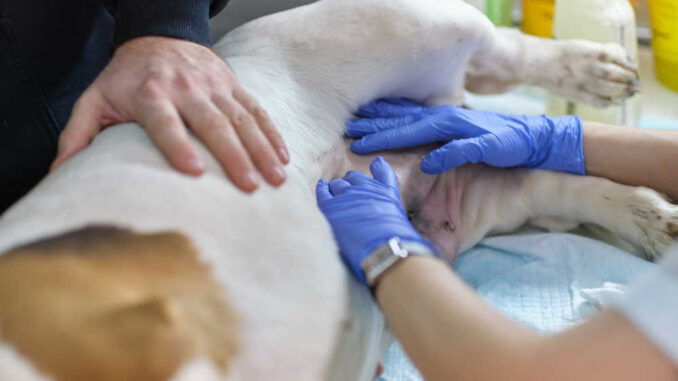
This article was updated on March 12th, 2024

Red spots, bumps, or rashes on a dog’s belly can have a multitude of causes, and getting to the bottom of things will ensure your dog is on the right treatment plan. In this article, our veterinarians, Dr. Linda Simon & Dr. Liz Guise, explain the most common causes of red spots on a dog’s belly, as well as what you can do to help your dog.
Key highlights:
– Red spots on a dog’s belly can be caused by many things, such as mites, allergies, and fungal infections
– Call your vet if your dog is uncomfortable, itchy, or has broken or oozing skin
– Most causes of red spots on a dog’s belly can be alleviated with steroids, antibiotics, and medicated washes
– Most cases can be easily solved with veterinary treatments
– In mild cases, the red spots might go away without intervention within a few days. Medicated washes and other home remedies can also help
– Diagnosis at the vet often involve skin tests, blood tests, and food allergy trials
5 things you should know about red spots on a dog’s belly
As concerning as it can be to see red spots on your dog’s belly, most cases can be easy to diagnose and treat with appropriate veterinary intervention.
1. Allergies, mites, and fungal infections are among the most common causes
If you see red spots or bumps on your dog’s belly, don’t panic. They are actually very common. Yes, you need to make a note of them and likely schedule a vet visit, but the majority of the time, we’re not dealing with anything too serious.
From infections to itchy allergies, there are a number of things to consider when a dog presents with red lesions on their belly or stomach. Let’s have a look at the most likely causes.
1. Allergies
Allergies are rampant in the canine population, with many dogs starting to show signs before their third birthday. Though any breed can be affected, Pedigrees, including the Westie, Frenchie, Pug, and Labrador, are most at risk.
Signs may start off subtly and get worse with time. Typical areas affected include the face, belly, and paws. The skin can be pink or red and you may see red spots or bumps on the stomach. This is especially true if there is a secondary infection, which is likely the case in this photo of a dog with food allergies:
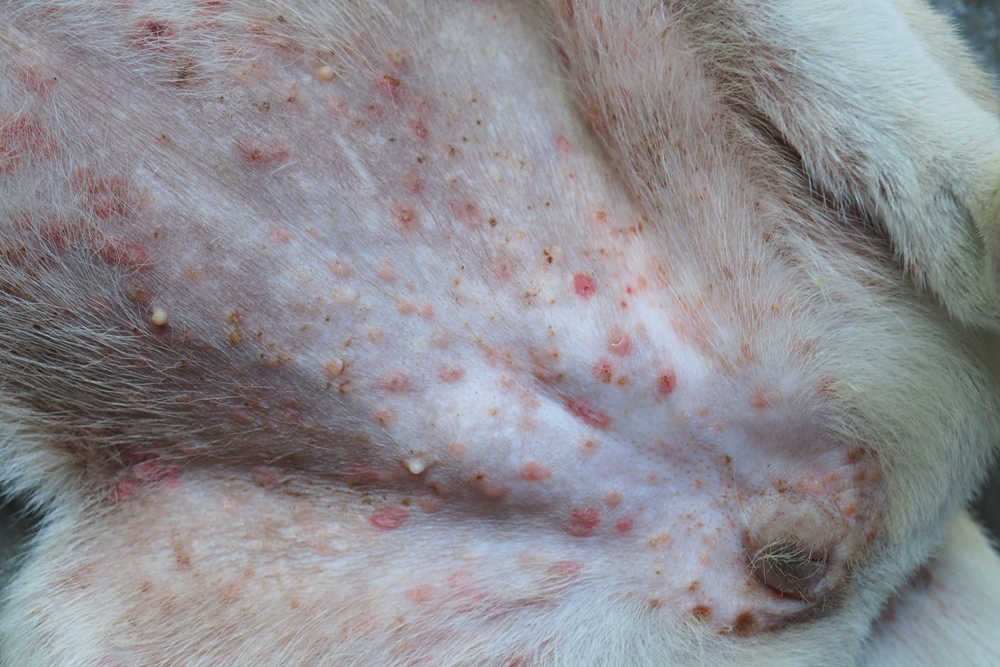
“Most dogs with allergies are uncomfortable and spend a lot of time scratching, chewing, and licking at their skin. While we cannot cure allergies, they can usually be well-managed. The aim here is to minimize flare-ups and to keep a dog as comfortable as possible.”
Below are two more pictures of dogs with red spots on their bellies due to allergies:
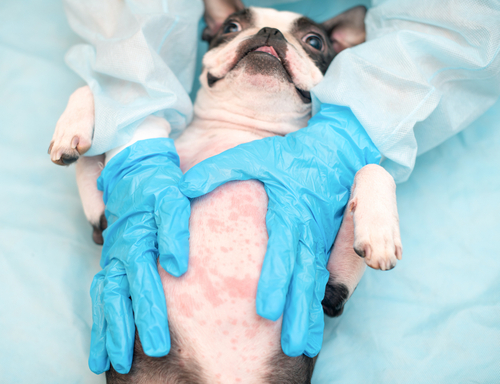
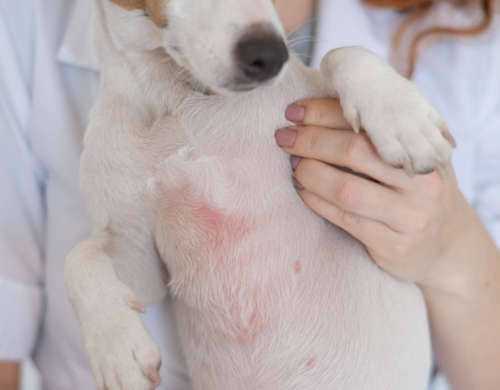
Treatment of allergies: we’d ideally identify the trigger and avoid it. Consult with your veterinarian on the right treatment for your dog—it may be feeding a hydrolyzed diet, sticking to the pavement when out walking, or bathing your dog’s paws and belly when you return from the dog park. You can also work with your vet to consider the home remedies listed later in this article.
Most patients benefit from ongoing allergy medicine such as immunotherapy, hyposensitization, Apoquel, or other medications. While Apoquel (alternatives to Apoquel), immunotherapy, and hyposensitization are more costly than steroids, they are s associated with fewer side effects and are better tolerated by most dogs.
Unfortunately, not every owner can afford the best treatments and alternatives may be tried first.
Learn more about Skin Issues Due to Allergies with pictures & veterinarian information.
2. Fungal infections
There are a number of fungal infections that can cause red bumps or red spots on a dog’s belly, including ringworm and Malasezzia yeast overgrowth. Over time, the infection can worsen, and the skin may change color and thicken into ‘elephant skin’ (the technical term is lichenification).
We typically see Malassezia overgrowth in dogs with severe and uncontrolled allergies. Below is a photo of a dog with this condition:
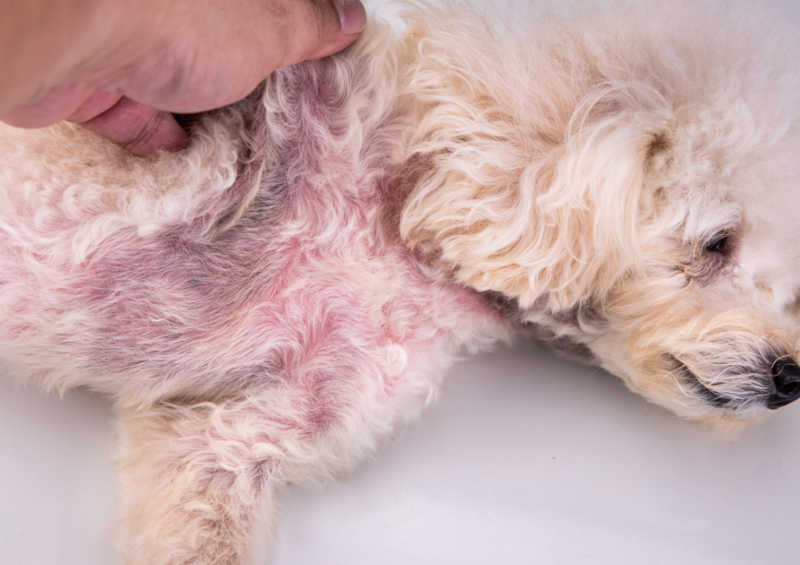
Another fungal infection, ringworm, is generally not itchy, and lesions tend to be quite small and localized. We usually see ringworm in younger pets, particularly those who have contact with cats or farm animals. It’s not uncommon for pets to pass ringworm on to humans, who develop ‘target lesions’ on their skin.
Below is a photo of a ringworm infection on a dog. View more pictures of ringworm in dogs or learn more about circular red spots.
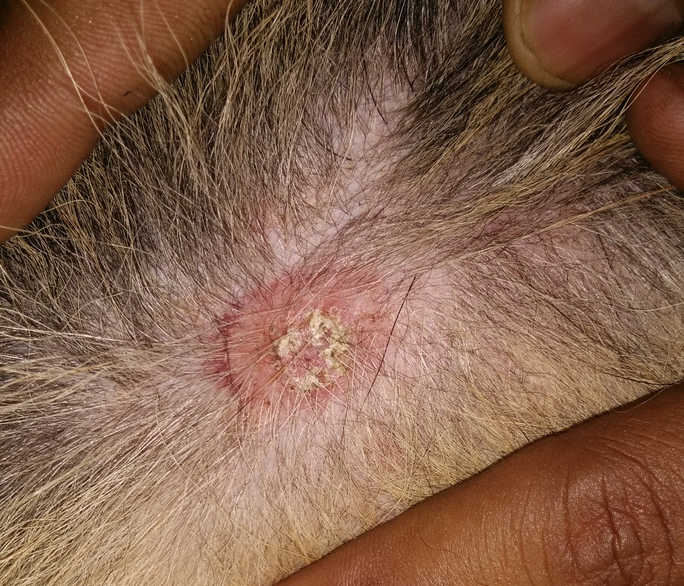
Treatment: Treatment for fungal infections varies. For Malassezia overgrowth, we first need to address the allergies before we are likely to see much improvement. Bathing with antifungal shampoo can be beneficial.
For ringworm infections, topical washes and antifungal creams can help manage the condition. Some dogs will need oral medicine.
Learn more about skin infections in dogs & how to treat.
3. Bacterial folliculitis
Folliculitis is a very common skin condition of dogs that often affects the belly. It causes red and raised lesions and can be linked to a number of medical issues, including allergies, acne, and hormonal disorders. You may see some hyperpigmentation and minor swelling.
Dogs with this condition are generally quite itchy and irritated, trying to rub their belly along the floor.
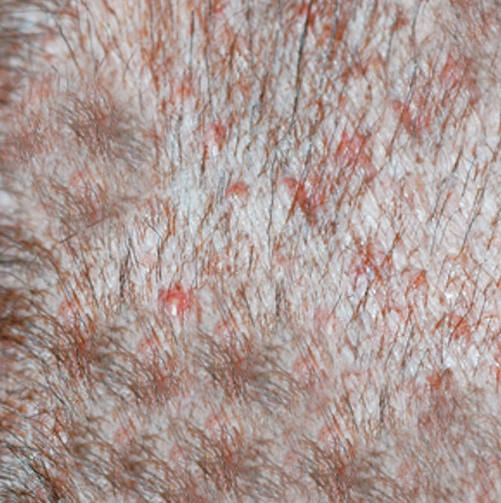
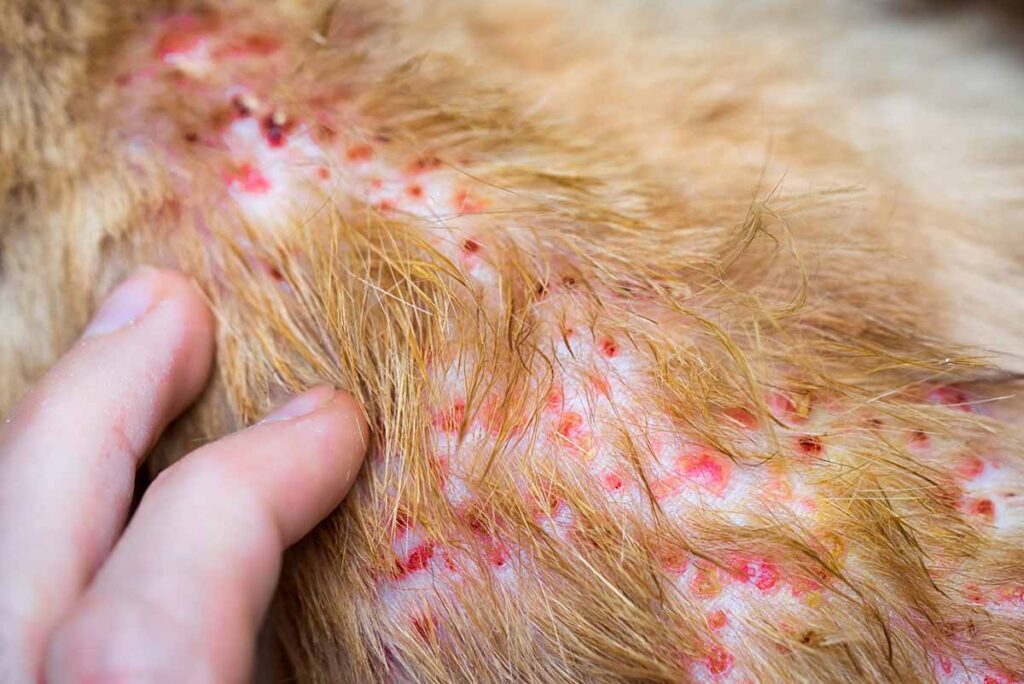
For a diagnosis, your vet will assess your dog’s skin and may also run dermatological tests such as a skin scrape and swab. If your dog has other symptoms (like excessive thirst or panting), your vet may run a hormonal blood profile.
Treatment: The treatment consists of several weeks of oral antibiotics, alongside a medicated wash. To prevent folliculitis from returning, you’ll also need to manage any underlying issues.
View more pictures of folliculitis – with recommendations from our veterinarians.
4. Mites
Fur loss associated with itchy red spots on the belly could be a sign of dog mites. Mange is caused by mites and causes crusting of the skin. In severe infestations, the skin may even look wrinkled.
Mites affect dogs of any age, though puppies are the most likely to be infested. As the little critters burrow under the skin, they cause intense irritation and inflammation. They can affect all parts of the body but we tend to find them mostly on the face, elbows, ankles, paws, and belly.
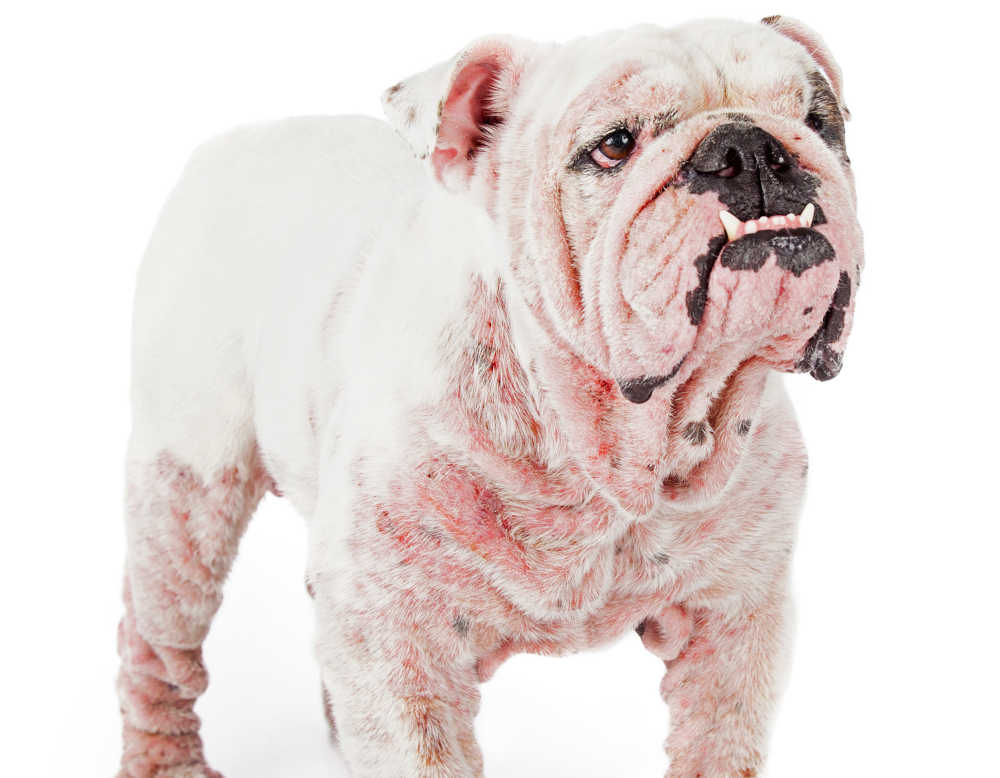
“Getting a diagnosis early on is crucial, as giving steroids to a dog with mites can make the symptoms worse.”
Mites are detected with a skin scrape. This is when your vet runs a sharp blade along the skin repeatedly. Then, the ooze and blood are analyzed under a microscope to find mites.
Treatment: Treatment involves anti-parasite dips and prescription oral treatments. These medicines are only available through the vet. You may also need to treat other pets exposed to the mites.
Learn more with our veterinarian article: what dog mites (mange) look like, and what to do.
5. Insect bites
The red circular lesions on this dog’s belly, are a result of gnat bites:
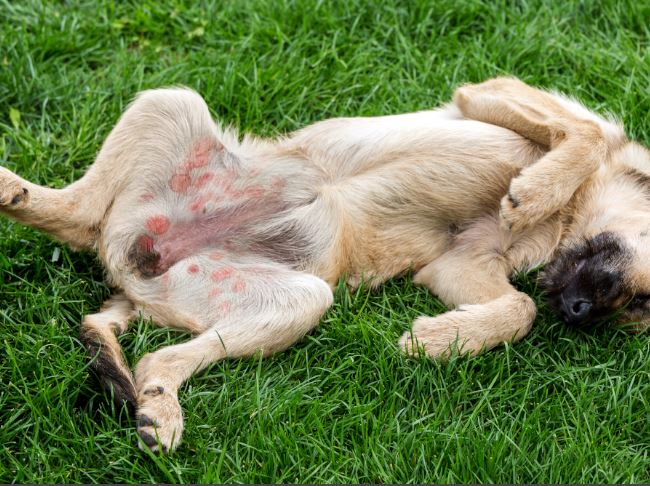
Initially, gnat bites can resemble ringworm or Staphylococcus skin infections. Typical symptoms include red ring-like lesions that look roughly like a bullseye, slight crusting, and mild itchiness. If your dog suffers from gnat bites, you’ll usually observe clusters of red spots in furless areas such as the belly and inner hind legs.
Treatment: Fortunately, gnat bites usually cause minor irritation and itching in dogs. To help soothe your dog’s discomfort, you can use an oatmeal bath, anti-itch shampoo, or salt water. The symptoms should resolve in a few days.
Occasionally, dogs will develop secondary infections from gnat bites. If your pooch’s lesions are oozing, spreading, or have a bad odor, contact your veterinarian to schedule an exam.
Although rare, some dogs will have severe allergic reactions to gnat bites. If you notice difficulty breathing, hives, or facial swelling, take your dog to the emergency clinic immediately.
Learn more about Gnat Bites or Insect Bites.
2. Take your dog to the vet if they are itchy or uncomfortable
If your dog is itchy, uncomfortable, and unhappy, take them to the vet ASAP. It dramatically affects a dog’s quality of life when they are constantly feeling the urge to lick and scratch at their skin. Dogs can exacerbate skin issues when they scratch red bumps or rashes on their bellies, potentially causing further inflammation, infection, or irritation.
You should also have your dog assessed promptly if they have broken or oozing skin.
Skin infections can spread quickly—the longer they go on, the harder they are to eradicate.
3. Veterinary intervention may not be required for a few red spots that get better with time
If you notice a few red spots on your dog’s belly but your dog doesn’t seem bothered, you don’t need to rush for an emergency appointment. It could be that your pet rubbed on a plant or had a few insect bites. In milder cases, the red spots might go away within a few days.
However, make sure you keep a close eye on the area, and have your pet seen by the vet if the skin is not getting better, or if your dog is showing other signs of discomfort or illness.
4. You can try home remedies like medicated washes and food allergy trials (with vet approval)
In some instances, it’s worth trying at-home remedies, particularly if your dog’s symptoms are mild. We do recommend checking in with your vet before trying these remedies:
1. Ensure your dog is up to date with effective flea and mite prevention
Those bought from supermarkets won’t always cut the mustard, so discuss the best choice for your dog with your vet.
2. Try a medicated wash
If you’ve noticed a slightly raised rash or some red bumps on your dog’s abdomen, I would try a medicated wash with chlorhexidine and ketoconazole, which may help to remove excess yeast and bacteria.
“We dilute neat Chlorhexidine 1:10 with water and use cotton wool to apply it to the affected skin. Leave it on for 5 minutes before rinsing it off. Repeat the process daily for 3-5 days.”
- Effectively Help Treat Skin Issues - PetHonesty's Chlorhexidine Shampoo is made with Chlorhexidine and Ketoconazole for the safest and most effective way to help treat your dog or cat's skin issues right in your own home. The shampoo is has a light cucumber melon scent to help combat smelly skin issues. Our advanced formula deodorizes the fur, helps remove knots from fur, and the essential oils contain the additional benefit of helping manage skin-related issues.
3. Prevent excessive licking
It also helps to stop any licking or chewing, which may mean investing in a buster collar. Dogs tend to prefer softer ones over the plastic variety.
- Неаling in comfort. This PRIMENS dog recovery collar is a dog cone alternative that would keep your pet from licking lnjurеd areas. Our collar works like a barrier around your dog’s neck that would prevent them from scratching and biting places they shouldn’t. With this collar on, your pet won’t reach the lnjuriеs in the leg, torso, or back area, so won’t be able to break stitches apart or introduce an lnfесtiоn into the wоund. Ensure faster recovery of your pet with our inflatable collar.
4. Work with your vet on a food allergy trial (If food allergies are suspected)
In case of food allergies, it’s sensible to do a food allergy trial. This is easiest to do by offering a hydrolyzed diet as the sole source of food. Since the proteins are broken down, your dog shouldn’t react to them. Hills z/d is one example of these foods.
“With any at-home remedy, watch closely to ensure signs are improving. If at any point your dog seems uncomfortable or the skin is worsening, it’s time to make a vet appointment.”
5. Skin tests can help vets choose the most helpful treatment options, like steroids and medicated washes
When it comes to skin issues, many look the same. That’s why getting the right diagnosis is key for treatment.
As well as getting a medical history from you and examining the skin, your vet may perform an in-house skin smear ($60-100), fur pluck ($50-100), and/or skin scrape ($50-100). Any areas of infection might be cultured and sent to the lab ($150-200). Finally, blood tests may be run to check for allergies ($300-600) or to rule out any hormonal disorders ($150-200).
Treatments will be specific to the condition your dog is dealing with. Furthermore, starting on the wrong treatment may lead to a delay in recovery.
Dogs with itchy red bumps may benefit from anti-itch medicines such as steroids and Apoquel. A short course of steroids is very inexpensive—about $20. Apoquel is more costly, with a two-week course for a medium dog costing closer to $60.
Infections are usually treated with both a medicated wash ($30-50) and oral antibiotics ($30-120) or anti-fungals ($40-100). When allergies are involved, the treatment should include allergen avoidance and/or a prescription diet, once triggers have been identified. Immunotherapy may be an option for some dogs and costs about $600-$800.
Recovery from red spots on a dog’s belly can take a few days to several weeks
Recovery will depend on the condition, but most skin disease starts to improve within a few days of starting the right treatment.
Deep skin infections take several weeks to resolve, and the same is true for mange. Mild skin allergies, however, can improve within just a couple of days of therapy. The sooner we start treatment, the quicker it tends to work.
Learn more: pictures of belly rashes on dogs.
Disclaimer: This website's content is not a substitute for veterinary care. Always consult with your veterinarian for healthcare decisions. Read More.






Be the first to comment